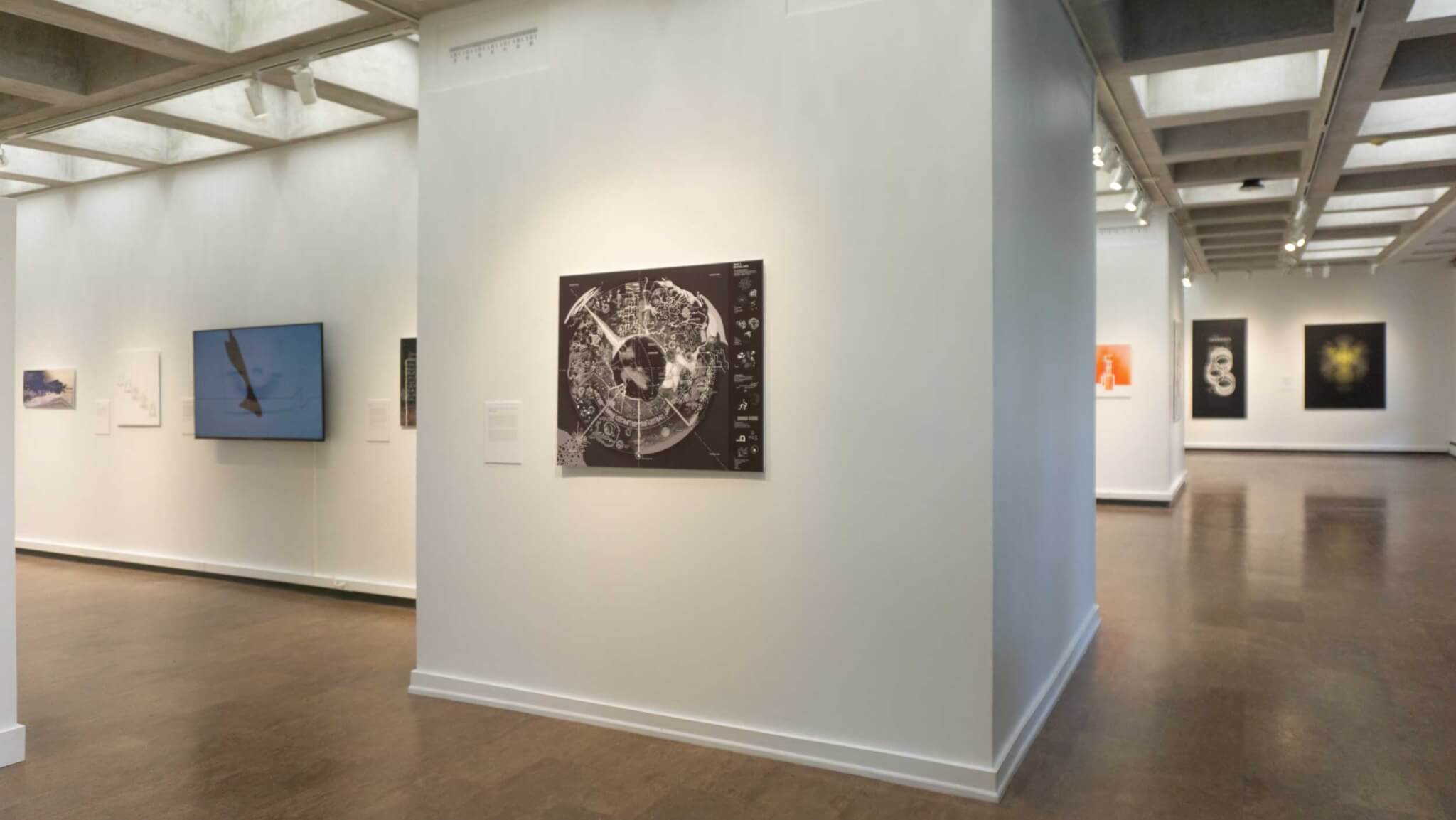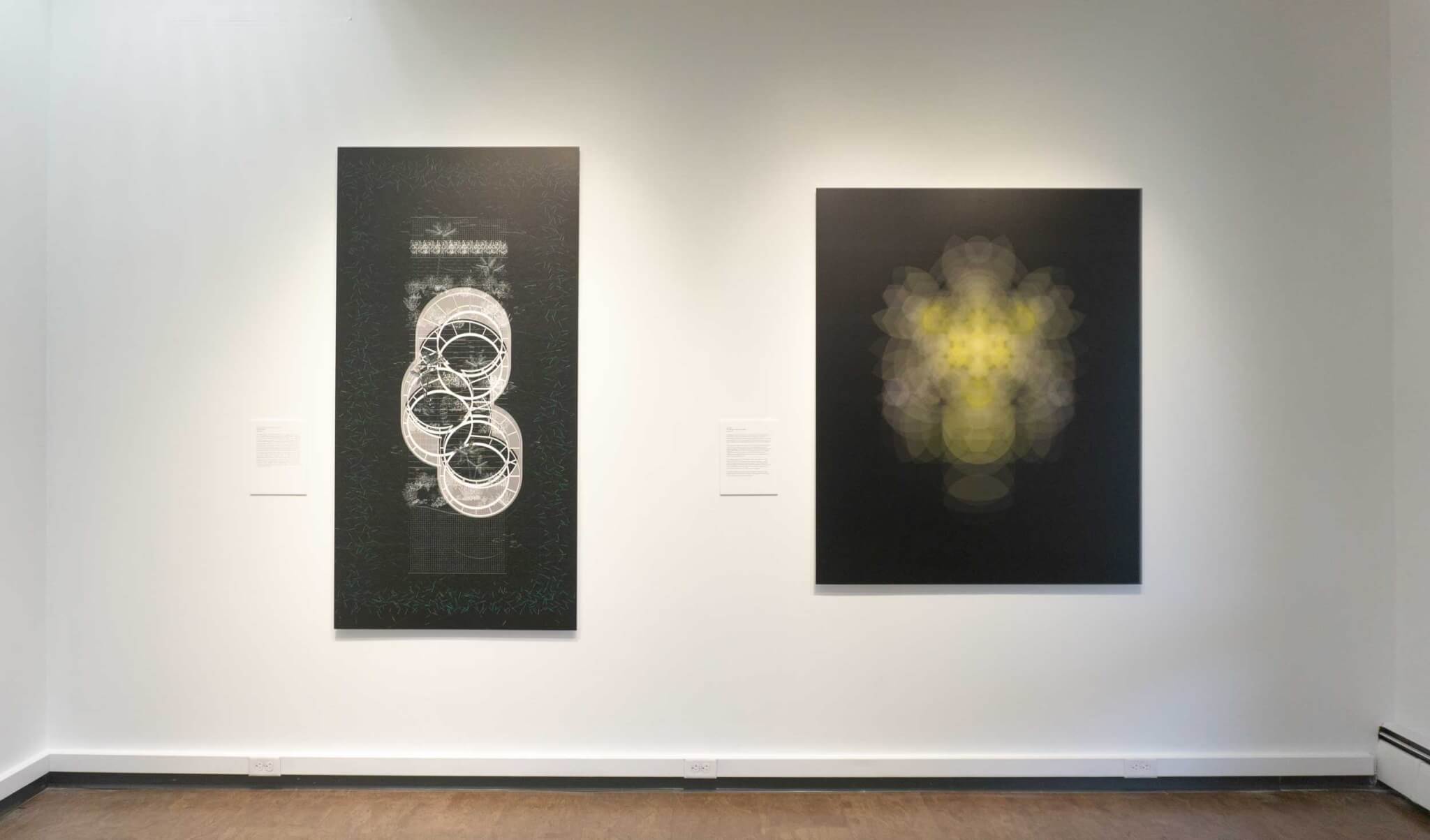Section as Cosmogram: From the Heavens to the Earth
Ithaca College
Ithaca, New York
August 28 – October 1, 2025
In 1969, architectural ecologist John McHale published Super Scale Survey Diagram in his book The Future of the Future (1969). It was an ambitious section drawing that spanned from the deepest ocean abyss through the horizon of sea level, to planetary space; from the molten core of the Earth through its crust, biosphere, atmosphere, and outward into the worlds of orbits and solar radiation. It is simultaneously a geological survey, ecological diagram, and cosmic map. The zone of human habitability is a thin band at the center. For McHale, humans had, by then, “enlarged their ecological niche to include the whole planet”
Superscale Survey situates every human act and artifact within an immense vertical field: from inner earth to outer space, every stratum is implicated. It makes explicit what architectural representation usually occludes: buildings, infrastructures, and even objects are suspended in vast ecological and cosmological systems that extend far beyond their immediate sites. McHale emphasized that no action—whether technological or architectural—was ever local. Each act reverberates upward and downward, across scales geological, biological, and astronomical.
Fifty-six years later, the drawings collected in David Salomon’s Section as Cosmogram resonate with this McHalean ambition in an expanded mode. The contemporary takes on the cosmogrammic section oscillate between perspectives, inviting the eye to flip from grounded detail to cosmic abstraction.
The first drawing, upon entering the Handwerker Gallery at Ithaca College, where the exhibition was staged, is perhaps the most-true section drawing: eden.exe by Pneumastudio (Cathryn Dwyre and Chris Perry). The large rendered/drawn/collaged section is presented as a postcard: Greetings from THE FUTURE—a future in which “biology, geology and technology conspire in the artfully cannibalized repurposing of the posthuman world.” Richly colored and textured sky, water, and geological strata present Eleuthra—a real island in the Bahamas—imagined in a fictional future.
Yet unlike this first welcome, and unlike McHale’s diagram, many of the drawings that follow deviate from the standard section as a straight cut. The Alchemist 47°28’20” N, 92°57’50” W – 46°45’11” N, 92°07’49” W (2025), a composite section by Lucito (Andrew Lucia and Iroha Ito), can be read as a 21st-century interpretation of the Super Scale Survey: strata of geology, atmosphere, and material culture coexist in one dense drawing. At the center is an observation building in Hull Rust Mine, in Minnesota’s Mesabi Iron Range, an “instrument” intended focus attention on earth, sky, and land. From the central section and its part-circle black sky, another circle appears to be a cloud; a continuation of sky on first reading flips, the body rotates, the view shifts from section to plan, and scales collapse into a new reading of topography. Beneath, we are flipped to section again and zoomed into close-up detail of iron-rich rock. And on the edges, the sun moves around the circular boundary of the drawing, vistas from the device pulled out as rectangular views. Lucito’s lines are porous, textures bleed into one another, and scales are deliberately unstable. While the ground, the sky, the underworld, and the cosmos are present in every section ever drawn, here, in this drawing—and in the built work, one assumes—they are drawn in, instrumentalized.

The Alchemist is the first of several circular drawings, a curious phenomenon in an exhibition on section. Ibañez Kim’s piece Los Angeles Hermetica Aire Limpio (2025) is another circle, a reconceived “hollow earth diagram,” in which L.A. is a “bubble of Ecology, where polluted air and water take center stage.” The drawing imagines a future in which bio-remediating organisms and new technologies scrub the air and water.

Terra Forma: Model Soil (2019) by the Society of Cartographic Objects (Alexandra Arènes, Soheil Hajmirbaba, Axelle Grégoire) is a circular map that represents the thickness of the earth in a “reversed globe.” This reversal, according to the contributors, allows not only a new reading of earth and sky, but also opens potential for a “subarchitecture” in which the boundaries between animate and inanimate dissolve.
José Ibarra’s Moray and the Inca Cosmology (2025) depicts a site “engineered to produce 27 microclimates” that connects agricultural cycles with cosmological ritual where “climate, terrain and myth are interwoven strata.” Again, the drawing straddles scales, invoking multitudes of reading. A section drawing occupies the lower third of the work, black earth, white air. In a black circle hovering above, the plan topography is shown as an orbital figure. The square-within-square produces a frame with four corners and four tabs allowing a further eight drawings to describe details at yet another scale, a stepped cross arrangement that directly alludes to the “chakana” or Andean cross—a 4,000-year-old element in Tiwanaku iconography symbolizing unity and connection across cosmological realms.
These concentric and zooming works call to mind Tim Ingold’s The Perception of the Environment (2000), in which the author describes how children perceive the earth at once as a ball in space and as a flat plane beneath their feet. These two visions are not contradictory but complementary: the child holds both globe and ground simultaneously, flipping between them depending on context. The cosmology is doubled, layered, lived.
The drawings exhibited in Section as Cosmogram echo this childlike oscillation. They never quite settle into McHale’s encyclopedic stability; instead, they invite the viewer to shift vantage points continually. One moment, we read the drawing as a conventional section, cutting through soil, structure, and atmosphere. The next, the ground has flipped to sky, the cut morphs into map, the building dissolves into planetary diagram.
This instability is the power of the exhibition. Where McHale rendered the planetary niche as a singular, encompassing cut, the contributors here embrace multiplicity: a kaleidoscopic cosmology that insists architecture must be understood both from the inside out (material, tectonic, infrastructural) and from the outside in (climate, geology, cosmic scale). Their drawings are cosmological not because they capture everything, but because they refuse to separate sky from ground, local from planetary, detail from atmosphere.

The architectural drawing has long been a vehicle for speculative imagination. From the section through a wall to the perspectival cut through a city, architects have used line and depth to represent warnings and manifestoes for the future. The word “drawing” itself carries a doubleness that is crucial here. To draw is to represent, to outline, to delineate. But it is also to draw in, to pull, to gather. These works do both. They represent buildings, grounds, skies, but they also draw together climates, cultures, politics, and materials. They refuse the narrow confines of drawing-as-image, insisting instead on drawing-as-practice: a way of thinking the building in relation to unrepresentable forces.
Today, the section drawing cannot stop at the tectonic. To cut through a building is also to cut through its climate footprint, its geological grounding, its political entanglements. To draw a wall is to draw its embodied carbon, its extractive supply chains, its future decay. In this sense, the works in Section as Cosmogram feel like urgent interventions: reminders that architectural representation must expand to include what Timothy Morton calls “hyperobjects”—things massively distributed in time and space, so large and complex that they confound ordinary perception: global warming, nuclear waste, the biosphere itself. To draw architecture today is therefore always to draw fragments of hyperobjects—to make visible what exceeds the eye, what resists representation.
Ultimately, Section as Cosmogram is about the expansion of drawing as a way of world-making. To cut is to situate, to relate, to connect. To draw is to gather. To pull in. The drawings exhibited reveal section as both analytical and cosmological, both precise and sublime. In an era defined by climate breakdown, political upheaval, and ecological crisis, architectural representation must move beyond the building as isolated object. It must encompass climate, topography, geology, culture, politics, weather. It must grapple with the unrepresentable, with hyperobjects that exceed human grasp. This collection of drawings takes on that challenge.
Caroline O’Donnell is the Edgar A. Tafel Professor of Architecture and former Chair of the Department of Architecture at Cornell University. Her research and teaching areas are in ecological design and theory.
→ Continue reading at The Architect's Newspaper
